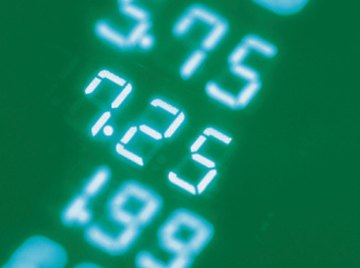
When you leave the world of whole numbers and start performing math operations with decimal numbers it may seem overwhelming. But decimals are nothing more than a fraction or a percent, like one you get on a math test, in disguise. You can also think of money, where dollars are to the left of a decimal point and cents are to the right. When adding and subtracting decimal numbers, all you have to do is line up the decimal points, and place the point in the same spot in your answer. With multiplication and division, it's slightly more complicated, but when you learn the tricks, you will move decimal points correctly with ease.
Move the decimal point to the right when multiplying a decimal number with a power of 10 number. Powers of 10 include: 10 to the power of 1, which equals 10; 10 to the power of 2, which equals 100; 10 to the power of 3, which equals 1,000; and so on. The trick is to count the number of zeros in the power of 10 number you are multiplying with and that is the number of spaces you need to move the decimal point. For example, if you are multiplying 1.234 x 100, there are two zeros in 100, so you move the point two times to the right to get the answer: 123.4. Other examples include: 4.568 x 10 = 45.68 and 0.876 x 1000 = 876.
Move the decimal point to the left when dividing a decimal number by a power of 10 number. As with multiplying decimals by power of 10 numbers, count the number of zeros to know how many spaces to move the decimal, but move the decimal in the opposite direction. For example, 456.89 / 10 means you are going to move the decimal once to the left since there is only one zero in 10; thus, the answer is 45.689.
Ignore the decimal points when multiplying two decimal numbers until the very end of the operation. Multiply as if you were multiplying two large numbers without decimal points. Once you have a total, count the digits to the right of each decimal point in the numbers you are multiplying to know where to move the decimal point. For example, if you are multiplying 2.34 x 4.5, the total before adding the decimal point is 10530. Count the digits to the right of each decimal point -- three digits in this case. Move the decimal point three spaces in the total, starting at the right and moving left. Thus, the answer is 10.530.
Move the decimal point of the divisor, the number outside the division box, completely to the right when doing long division. If you move the decimal point of the divisor, you have to move the decimal point of the dividend, the number inside the division box, the same number of places. For example, if you are dividing 456.7 by 2.34, you would move the decimal point in the divisor completely to the right to yield 234; since you moved the decimal point two places within the divisor, you have to move the dividend's decimal spot two places to the right to get 45670. (Adding a zero on the end is the same as moving one decimal place.) If the divisor does not have a decimal point, you do not have to adjust any decimal points, even if the dividend has a decimal point. Before starting the long division, place a decimal point on top of the division box, where the answer goes, right above the decimal point in the dividend.
References
About the Author
Michelle Brunet has published articles in newspapers and magazines such as "The Coast," "Our Children," "Arts East," "Halifax Magazine" and "Atlantic Books Today." She earned a Bachelor of Science in environmental studies from Saint Mary's University and a Bachelor of Education from Lakehead University.
Photo Credits
Ablestock.com/AbleStock.com/Getty Images
